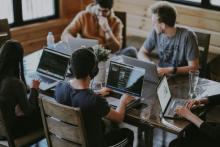Even before the coronavirus struck, the reign of the office as a permanent fixture in modern professional life had begun to look a bit shaky. According to Catherine Nixey’s article, Death of the Office, she contends “a combination of rising rents, the digital revolution and increased demands for flexible working meant its population was slowly emigrating to a different milieu.” Most scientists will still need to go into labs to run experiments, but many administrators who have made the transition to full-time remote work completely seamlessly find themselves asking, “Is the office now completely antiquated?”
In the 20th century, factory designers turned
their attention to offices. Sure, the moving parts were human but to optimize
efficiency, many of the same principles were applied and so the open-plan
office was born. Offices have long provoked strong sentiments. Poet John Betjeman
wished for bombs to fall and “blow to smithereens/Those air-conditioned, bright
canteens.” Despite the lack of aesthetics, research shows that office space can
have profound effects on one’s physical and mental health and that offices
might be more unpleasant for women. Air temperature tends to be set to suit the
metabolic rates for a 154-pound, 40-year-old man leaving many women to freeze.
The most revolutionary aspect of the office wasn’t really focused so much on
the building and space as just how much time we spent in them AND commuting to
them. During the pandemic, many have found luxurious relief and freedom from
their daily commute. Likewise, parents have found that they can no longer hide
or keep up the pretense that their children don’t exist as they pop into Zoom
meetings or can be heard crying during a staff call. Emily Oster, Professor of
Economics at Brown and author of “Cribsheet” notes that parents often tried to
keep a false pretense of not being distracted by personal obligations even
going as far as “pretending they are themselves ill so that they can care for a
sick infant lest people think they are prioritizing parenting.”
With the digital revolution risking redundancy, offices felt their power
slipping away and many companies tried to up their game by bringing in
ping-pong tables and snack bars in an attempt to keep workers perpetually in
their hold.
With all of that said, humans need social encounters and work is often better
when collaborating. Offices often filled this need and brought with it an artifice
of order and productivity. It may be too early to say what will happen to the
office permanently, but it could be the start of another revolution.




